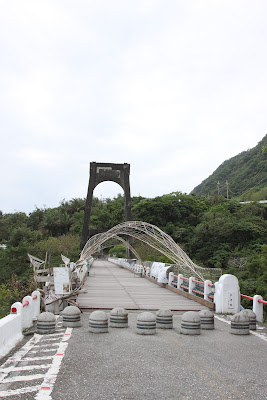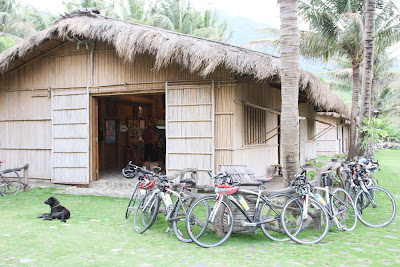Before I visited Donghe township, I was unfamiliar with this area. It was never on my map and had never been a popular place in Taiwan. The only thing I heard about it was its famous steamed meat buns. Most travelers just parked and ordered the steamed meat buns to go and then continued their journey.
It was also not on our schedule this time when we visited Taitung county; however, for some reasons we started exploring this small town. The population in Donghe is only 1,367 people. The population is divided into two groups which are 993 indigenous people the Amis tribe and 374 of Han decent.
 |
| The Chinese sausage vendor sold their BBQ sausages next to the store. The steamed meat bun store not only made its own profit but also gave other vendors some business opportunities. |
 |
| This is the old street in Donghe town. There was almost no traffic at all. It was very quiet. |
 |
| There is a surfing store in this small town . I was surprised what the small town could offer. |
We drove on this red bridge traveling north and found
there was an old bridge inland not far away from the main highway.
 |
| This is the old bridge which was built in 1927 by the Japanese government. It is 127 meter long. There is a small park and toilet next to the bridge. |
 |
| The view is off Mawuku Creek from the old bridge |
 |
| We saw some roosters walking on the ridge of the cliff next to the trail. We were guessing how they got there. |
 |
| Life is simple in the countryside of Taiwan. The locals use the land and maximize its use. Small plots of land along the river were used for gardens growing vegtables. |
 |
| There were some bamboo trees in clusters making squeaky sounds from the wind blowing and the trees bending. The sound made walking on the trail a little spooky. |
 |
| The river flows into the Pacific Ocean. |
 |
| This dog made me recall a dog-on-a-raft shape jade relic from the excavation of a archaeological site in this area. |
 |
| The view of the old and new bridges |
 |
| This was our return route.We were going to go through this narrow pass. My husband doubted if we could make it throught this passage? We barely made it. It was one of the excitements of this trip. |
 |
| This was a short trip about 30 minutes round trip. They were ready for aboriginal food for their lunch. |
 |
| The owner invited us to have a lunch with them. We followed the trail to their place. |
 |
| This grass top roof and bamboo or wood frame is the traditional Amis house structure. It is hiden from the highway 11, so travelers can't see the house. |
 |
| I thought they hosted a lot of bicyclists for their package deal. |
 |
| Inside the restaurant: riding bicycle and rafting, they were starving and craving for the food. |
 |
| I asked the female host if I could take a look at their rooms. She showed me a room which could host 8 people. |
 |
| The view from the B&B property |
 |
| There are two rooms for hosting 8 people per room and two rooms for 12 sleepers in one room. That was why the male host told me that he normally takes a group of people for the tours. |
 |
| There are also some camp sites here but they don't furnish any camping gear. You have bring your own. They offer public showers and toilets. |
 |
| A fire pit is inside the restaurant area. |
 |
| The ascription of their tribe |
 |
| Taiwan has many nice bicycle trails around the island. Giant has many bicycle tour packages. This is its service vehicle for taking people riding around Taiwan. |
We didn't stay for lunch with them because I had the steamed meat bun and was still full. We said thank to the hosts for their hospitality. We decided to take Highway 23 which is next to the Donghe bridge crossing the mountain range to the East Rifted Valley. We drove about 15 or 20 minutes and saw a sign saying "Caution Monkeys." We wondered if there were monkeys in this area? Not far from the sign, we saw people parking their vehicle along the sides and monkeys sitting in the middle of the road or on the road side. We stopped our car and I walked out to see and take pictures of the monkeys.
 |
| People were close to these monkeys and they seemed not to be afraid of human beings. |
 |
| This monkey mommy was watching her babies. |
 |
| This monkey had the orange skin in its mouth. It climbed up the light poll very fast. |
 |
| We were amazed how they could grab the rocks and walk along the cliff very well. |
If you visit this area, please don't feed the monkeys.
This is the website for the B&B: http://marogarog.tacocity.com.tw/
GPS coordinate: N22 58'26.33 E121 18'28.80











No comments:
Post a Comment
Thank you for reading my blog and welcome to leave your comment!